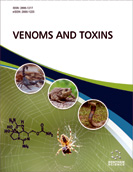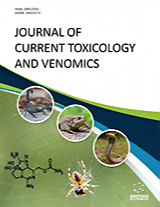Abstract
Background: Androctonus mauretanicus (Am ) is one of the most hazardous scorpions in Morocco and has a highly toxic venom responsible for severe cases of envenomation. However, few studies have focused on deciphering its proteic composition.
Objectives: Herein, we aim to map out the complete proteome of the Am venom filtrate to highlight its complexity and the polymorphism of its toxic content. This, in turn, will lead to a deeper understanding of the toxins’ mechanism of action and will help uncover those with therapeutic potential.
Methods: Top-down and bottom-up proteomic approaches were used complementarily to decipher the proteome of the Am venom. These approaches were carried out on nano-high liquid chromatography coupled to nano-electrospray tandem mass spectrometry (Nano-LC-ESI-MS/MS).
Results: Am venom encloses a complex mixture of 269 different compounds with molecular weights ranging from 1618.74 to 14 214.84 Da. The most abundant ones showed masses from 6185.92 to 7899.53 Da (53.89%) followed by those ranging from 2079.25 to 5969.63 Da (37.81%). Interestingly, the combination of the results of both approaches allowed the screening of a total of 112 peptides. The highest percentage was represented by neuropeptides (87%), including NaTxs, KTxs, ClTxs, venom proteins, venom neuropeptides, and myotropic neuropeptides. Moreover, other peptides were identified, such as antimicrobial peptides, amphipathic peptides, cysteine-rich venom peptides, enzymes, kunitz-type inhibitors and orphan peptides.
Conclusion: The Am venom appears to contain a great number of diverse peptides, some of which could prospectively be exploited for their pharmaceutical potential.
Keywords: Scorpion venom, Androctonus mauretanicus scorpion, toxins, top-down, bottom-up, venomic.
[http://dx.doi.org/10.1016/j.actatropica.2008.05.021] [PMID: 18579104]
[http://dx.doi.org/10.1016/0041-0101(75)90131-2] [PMID: 1166465]
[http://dx.doi.org/10.1590/S0036-46651994000100011] [PMID: 7997776]
[http://dx.doi.org/10.1155/2010/903295] [PMID: 20300540]
[http://dx.doi.org/10.1590/0037-8682-0237-2015] [PMID: 26676487]
[http://dx.doi.org/10.5812/ijp.199] [PMID: 26199687]
[http://dx.doi.org/10.2174/092986609788923329] [PMID: 19689419]
[http://dx.doi.org/10.1016/j.wem.2015.04.005] [PMID: 26432426]
[http://dx.doi.org/10.1046/j.1432-1327.1999.00625.x] [PMID: 10491073]
[http://dx.doi.org/10.1016/j.toxicon.2005.09.006] [PMID: 16274721]
[http://dx.doi.org/10.1016/j.toxicon.2006.09.022] [PMID: 17239913]
[http://dx.doi.org/10.1016/j.toxicon.2013.07.012] [PMID: 23891887]
[http://dx.doi.org/10.3390/toxins5122456] [PMID: 24351712]
[http://dx.doi.org/10.1016/j.toxicon.2014.06.006] [PMID: 24951876]
[http://dx.doi.org/10.4269/ajtmh.2000.62.277] [PMID: 10813485]
[http://dx.doi.org/10.3390/toxins6061873] [PMID: 24926799]
[http://dx.doi.org/10.1016/j.heliyon.2016.e00221]
[http://dx.doi.org/10.1016/0041-0101(85)90114-X] [PMID: 3992595]
[http://dx.doi.org/10.1016/0041-0101(91)90078-6] [PMID: 1949066]
[http://dx.doi.org/10.1016/0014-5793(93)80583-G] [PMID: 8385026]
[http://dx.doi.org/10.1111/j.1399-3011.1996.tb00870.x] [PMID: 8985784]
[http://dx.doi.org/10.1046/j.1432-1033.2002.03294.x] [PMID: 12473099]
[http://dx.doi.org/10.1016/j.toxicon.2007.12.012] [PMID: 18243273]
[http://dx.doi.org/10.1016/j.toxicon.2013.03.001] [PMID: 23500507]
[http://dx.doi.org/10.1002/jms.346] [PMID: 12124999]
[http://dx.doi.org/10.1074/mcp.R500012-MCP200] [PMID: 16009968]
[http://dx.doi.org/10.1038/nmeth.2216] [PMID: 23132117]
[http://dx.doi.org/10.1038/nmeth.2369] [PMID: 23443629]
[http://dx.doi.org/10.1074/mcp.M115.056523] [PMID: 27178327]
[http://dx.doi.org/10.1021/acs.analchem.5b04230] [PMID: 26558748]
[http://dx.doi.org/10.1016/j.jprot.2017.02.002] [PMID: 28188863]
[http://dx.doi.org/10.1186/s40409-017-0135-6] [PMID: 29075288]
[http://dx.doi.org/10.1186/1678-9199-19-5] [PMID: 23849043]
[http://dx.doi.org/10.1152/ajpcell.1993.264.2.C361] [PMID: 8383429]
[http://dx.doi.org/10.3892/ol.2012.1049] [PMID: 23420047]
[http://dx.doi.org/10.1016/0003-9861(77)90053-4] [PMID: 879793]
[http://dx.doi.org/10.1016/S0041-0101(01)00122-2] [PMID: 11478957]
[http://dx.doi.org/10.3390/toxins11050247] [PMID: 31052267]
[http://dx.doi.org/10.1016/j.ibmb.2004.07.005] [PMID: 15522610]
[http://dx.doi.org/10.1002/cne.20650] [PMID: 16041719]
[http://dx.doi.org/10.1016/S0014-5793(00)01384-3] [PMID: 10767415]
[http://dx.doi.org/10.1074/jbc.271.47.29537] [PMID: 8939880]
[http://dx.doi.org/10.1007/s10989-013-9350-3]
[http://dx.doi.org/10.1186/s12864-019-6013-6] [PMID: 31409288]
[http://dx.doi.org/10.1016/j.bbrc.2008.04.104] [PMID: 18445483]
[http://dx.doi.org/10.1016/j.toxicon.2008.07.010] [PMID: 18718845]
[http://dx.doi.org/10.1016/j.toxicon.2013.07.016] [PMID: 23911732]
[http://dx.doi.org/10.1371/journal.pntd.0002693] [PMID: 24551256]
[http://dx.doi.org/10.1016/j.toxicon.2014.07.014] [PMID: 25091350]
[http://dx.doi.org/10.1016/j.peptides.2016.05.008] [PMID: 27221550]
[http://dx.doi.org/10.1016/j.peptides.2015.05.013] [PMID: 26056922]
[http://dx.doi.org/10.3390/toxins8120348] [PMID: 27886129]
[http://dx.doi.org/10.1371/journal.pone.0193739] [PMID: 29561852]
[http://dx.doi.org/10.3390/toxins10090359] [PMID: 30189638]
[http://dx.doi.org/10.1021/pr4003068] [PMID: 23731212]
[http://dx.doi.org/10.1016/j.toxicon.2011.12.013] [PMID: 22245624]
[http://dx.doi.org/10.1016/j.abb.2017.12.012] [PMID: 29258861]
[http://dx.doi.org/10.1016/j.toxicon.2015.09.034] [PMID: 26415902]
[http://dx.doi.org/10.1074/jbc.M115.637611] [PMID: 25792741]
[http://dx.doi.org/10.1016/j.toxicon.2008.12.007] [PMID: 19103215]
[http://dx.doi.org/10.1007/s13149-014-0332-7] [PMID: 24402964]
 23
23 1
1




